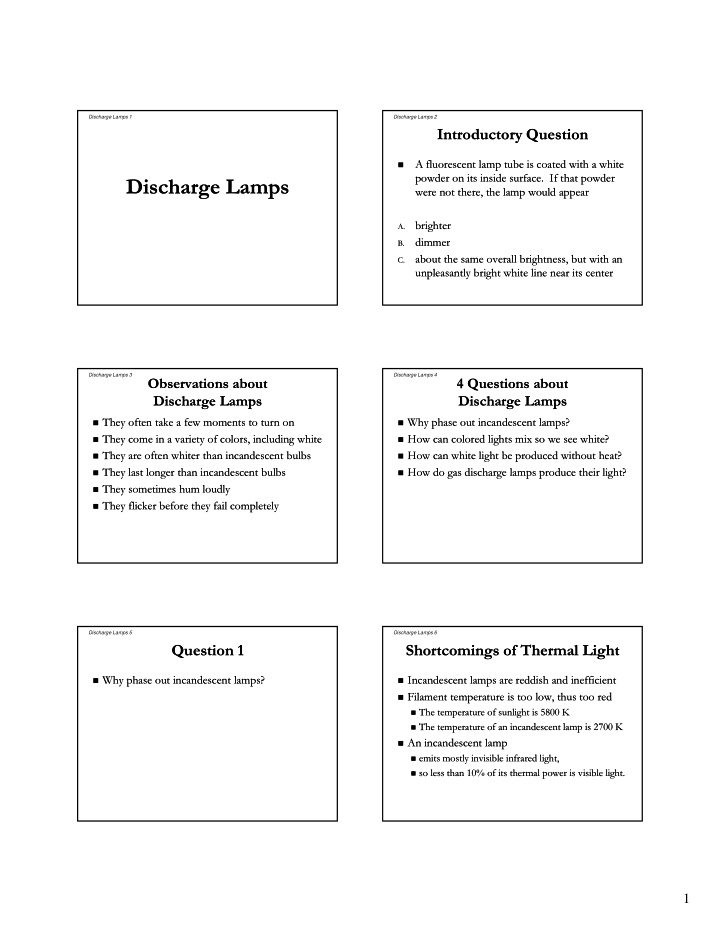



Discharge Lamps 1 Discharge Lamps 2 Introductory Question Introductory Question A fluorescent lamp tube is coated with a white A fluorescent lamp tube is coated with a white � powder on its inside surface. If that powder powder on its inside surface. If that powder Discharge Lamps Discharge Lamps were not there, the lamp would appear were not there, the lamp would appear brighter brighter A. A. dimmer dimmer B. B. about the same overall brightness, but with an about the same overall brightness, but with an C. C. unpleasantly bright white line near its center unpleasantly bright white line near its center Discharge Lamps 3 Discharge Lamps 4 Observations about Observations about 4 Questions about 4 Questions about Discharge Lamps Discharge Lamps Discharge Lamps Discharge Lamps � They often take a few moments to turn on They often take a few moments to turn on � Why phase out incandescent lamps? Why phase out incandescent lamps? � � They come in a variety of colors, including white They come in a variety of colors, including white � How can colored lights mix so we see white? How can colored lights mix so we see white? � � They are often whiter than incandescent bulbs They are often whiter than incandescent bulbs � How can white light be produced without heat? How can white light be produced without heat? � They last longer than incandescent bulbs They last longer than incandescent bulbs � How do gas discharge lamps produce their light? How do gas discharge lamps produce their light? � They sometimes hum loudly They sometimes hum loudly � They flicker before they fail completely They flicker before they fail completely Discharge Lamps 5 Discharge Lamps 6 Question 1 Question 1 Shortcomings of Thermal Light Shortcomings of Thermal Light � Why phase out incandescent lamps? Why phase out incandescent lamps? � Incandescent lamps are reddish and inefficient Incandescent lamps are reddish and inefficient � � Filament temperature is too low, thus too red Filament temperature is too low, thus too red � The temperature of sunlight is 5800 K The temperature of sunlight is 5800 K � The temperature of an incandescent lamp is 2700 K Th The temperature of an incandescent lamp is 2700 K Th f f i i d d l l i 2700 K i 2700 K � An incandescent lamp An incandescent lamp � emits mostly invisible infrared light, emits mostly invisible infrared light, � so less than 10% of its thermal power is visible light. so less than 10% of its thermal power is visible light. 1
Discharge Lamps 7 Discharge Lamps 8 Question 2 Question 2 Seeing in Color Seeing in Color � How can colored lights mix so we see white? How can colored lights mix so we see white? � We have three groups of light We have three groups of light- -sensing cone cells sensing cone cells � Their peak responses are to red, green, and blue light Their peak responses are to red, green, and blue light � Those are therefore the primary colors of light Those are therefore the primary colors of light � When the primaries mix, we see others colors Wh Wh When the primaries mix, we see others colors h h i i i i i i h h l l � When the primaries mix evenly, we see white When the primaries mix evenly, we see white Discharge Lamps 9 Discharge Lamps 10 Question 3 Question 3 Fluorescent Lamps (Part 1) Fluorescent Lamps (Part 1) � How can white light be produced without heat? How can white light be produced without heat? � Fluorescent tubes Fluorescent tubes � contain low density gas and metal electrodes, contain low density gas and metal electrodes, � which inject free electric charges into the gas which inject free electric charges into the gas � to form a plasma � t f rm to form a plasma— t f rm pl m pl m —a gas of charged particles a gas of charged particles f h r f h r d p rti l d p rti l � and electric fields cause current to flow in the plasma. and electric fields cause current to flow in the plasma. Discharge Lamps 11 Discharge Lamps 12 Clicker Question Clicker Question Clicker Question Clicker Question � Both a gas and a plasma contain electric charges, Both a gas and a plasma contain electric charges, � If electrons and atoms were both perfectly elastic If electrons and atoms were both perfectly elastic so why can only a plasma conduct electric so why can only a plasma conduct electric balls, what would happen to the work done on balls, what would happen to the work done on current? current? the electrons by the lamp’s electric field? the electrons by the lamp’s electric field? A. Each gas particle has zero net charge. Each gas particle has zero net charge. A. It would become kinetic energy in the electrons. It would become kinetic energy in the electrons. A. A. B. A gas has zero net charge. A gas has zero net charge. B. It would become kinetic energy in the atoms. It would become kinetic energy in the atoms. B. B. C. A gas contains only negative charges. A gas contains only negative charges. C. It would be zero. It would be zero. C. C. D. Gas particles aren’t mobile. Gas particles aren’t mobile. D. Collisions would turn it into thermal energy. Collisions would turn it into thermal energy. D. D. 2
Recommend
More recommend